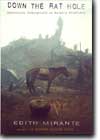| Our Publications | ||
| Books by Title | ||
| Books by Author | ||
| Books by Country | ||
| E-books | ||
| About | ||
| Orchid Press E-books | ||
| Distributed E-books | ||
| Our Bookshop | ||
| About Us | ||
| Browse Shop | ||
| How to Buy | ||
| Contact Us | ||
| WE BUY BOOKS AND LIBRARIES | ||
|
||
Book Reviews

Down The Rat Hole:
Adventures Underground on the Burma Frontier
byEdith Mirante
2005. 192 pp., 3 colour plates, 3 maps, 21.5 x 15.2 cm., softcover.
ISBN-10: 974-524-050-8 $21.00
ISBN-13: 978-974-524-050-6
The Frontierslady
A female author’s exciting, but ugly account of her travels in Burma’s border areas
Book review by Bertil Lintner
(Irrawaddy Magazine, April 2005)
Edith Mirante got her first pair of moccasins when she was two years old. They were made of beaded deerskin, and she put them on and walked out of her family home on Atlantic City’s Boardwalk. She hurried down the road, alone and proud of her new moccasins, the American Indians’ traditional shoes. That was her first adventure on the unsafe path that would eventually lead to Burma’s remotest frontiers.
Mirante arrived in Thailand in the early 1980s and, again alone, visited Shan, Karen, Pao-O, Karen, Karenni and Mon ethnic minority rebels along the border with Burma. She went further, to the isolated archipelago of the Tenasserim coast, where she and her Mon guerrilla friends “camped like buccaneers on an obscure island in the Andaman Sea. We were pirates, our treasures the interviews, images, information.
Established, respected human rights groups could not go to those places. I had become a pirate, a human rights pirate, raiding the coast for all the information I could thieve from Ne Win’s Burma,” as she wrote in her first, 1993 book, Burmese Looking Glass: A Human Rights Adventure and a Jungle Revolution.
For Mirante is no ordinary adventurer. Apart from her books, she has written numerous reports about human rights abuses in Burma’s frontier areas. That was not popular with everybody, and in 1988 she was arrested on her return to Thailand from one of her trips to a guerrilla camp on the other side of the border. She was subsequently deported and remains blacklisted in Thailand. But that did not stop her from visiting areas of Burma not controlled by the government in Rangoon, approaching from other directions. Having finished her first book, she immediately set out to write another on her later travels. The outcome: Down the Rat Hole, which, like Burmese Looking Glass, is beautifully written. It is also outright exciting because she really does go through one adventure after another.
She was trapped in a cyclone in Bangladesh while interviewing refugees from Burma. She sneaked into Kachin State from China with her hair dyed black and disguised as a Muslim woman. She traveled to Manipur, a restricted area in India’s northeast, as member of a “bona fide tour group”—but that was only an excuse to get into an area riddled with ethnic strife, drug abuse, and AIDS. She crossed the Mekong river into Burma’s Shan State from Laos, and everywhere documented forced labor, rape and torture.
But Down the Rat Hole also reflects her disappointment with some of the rebel groups she once had felt so close to. When she first trekked into Kachin State in 1991, she met rebels who wanted to change the politics of Burma, students who had taken part in the 1988 urban uprising, and then fled to the border areas where they had teamed up with various ethnic rebel groups to fight against Burma’s military government. When she returned to Kachin State 11 years later, the rebels had signed a ceasefire agreement with the same government. Now, they were fighting among themselves over lucrative logging concessions.
Nothing she had heard about Pianma, a small town on the Kachin border, she wrote, “really prepared me for the shock of it. I’d expected something like a Pacific Northwest logging town-one or two lumberyards-but Pianma had at least 40. It was a horizontal forest, piled high to the sky. This was Kachin wood. Logging had been banned on the Chinese side of the border, in Yunnan province, so each log bore a red stamp certifying that it came from Burma . Pianma was the graphic evidence of the demise of the Kachin forests.” It was also clear evidence of the collapse of the Kachin Independence Organization, or KIO, as a political organization and resistance force. Corruption was widespread and no one was any longer interested in documenting human-rights abuses. She was told of forced labor and rape by government troops, but the KIO had publicized none of it—“silent, complicit in their new role as timber warlords,” as Mirante puts it.
But it is not all doom and gloom, she notes. Opposition leader Aung San Suu Kyi may be back under house arrest, but she remains a symbol of freedom. The Kachin forests may be gone, but the American oil giant Unocal is to be tried in court for its Tenasserim pipeline security campaign. The little girl who once ventured out in her deerskin moccasins has become older, wiser, and perhaps a bit despondent. But she has not lost her ability to write, and to continue documenting what she perceives as gross violations of human dignity. Read this book. It’s worth it.
[Read a review from the South China Morning Post] [More Orchid Press Reviews]
PO Box 70, Trinity TB, NL, A0C 2S0, Canada
Telephone: +1 709-330-4703